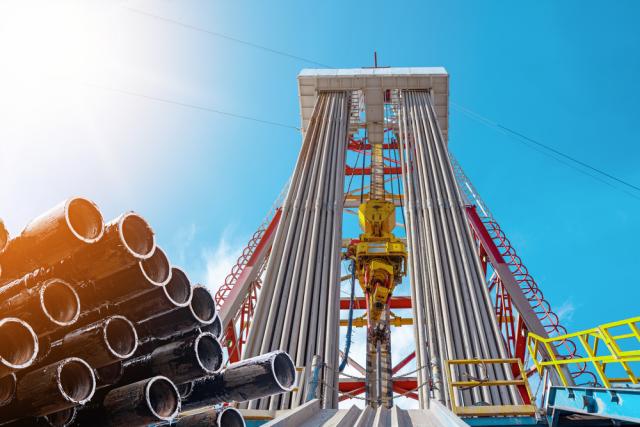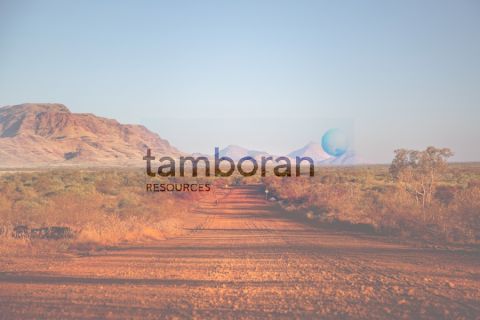
In this photo, an oil and gas drilling rig operation can be seen. Comstock Resources Inc.’s first far stepout Haynesville wildcat’s results are a win, while its first Bossier well in the new play is indicating an EUR of 3.5 Bcf per 1,000 feet of lateral. (Source: Shutterstock.com)
Comstock Resources Inc.’s first far stepout Haynesville wildcat’s results are a win, while its first Bossier well in the new play is indicating an EUR of 3.5 Bcf per 1,000 feet of lateral.
“We keep drilling these wells, so obviously we're not totally displeased with what we've seen,” Jay Allison, Comstock chairman and CEO, told securities analysts and investors in an earnings call Aug. 2.
“And we're going to continue to drill the wells.”
The first Haynesville well, McCullough Ingram A #1, in the new play in Robertson and Leon counties was turned into sales this past June 20. It IP’ed at 35 MMcf/d from 8,256 ft of completed lateral at a total vertical depth of 17,836 ft.
The reported IP is what the well has shown to date while it is still cleaning up, said Dan Harrison, Comstock COO.
Meanwhile on the EUR estimate, the first Bossier well, the Circle M #1H, came in with 37 MMcf/d from a 7,900-ft lateral in April of 2022. The estimate of 3.5 Bcf per 1,000 feet of lateral is based on a Netherland Sewell & Associates Inc. analysis.
Comstock also reported Aug. 2 that a fourth Bossier well, Dinkins JG #1, IP’ed at 34 MMcf/ from 9,565 ft of completed lateral in Lower Bossier at a total vertical depth of 18,042 ft. The well was put into sales on May 24.
Two more wells are being completed currently and are expected to be online before October. Another well is being drilled.
Comstock dropped one of its two rigs drilling in the play to pick up a newer rig arriving later this month, Harrison said. The plan is to have three rigs in the play in 2024 to HBP its roughly 200,000 net acres.
Comstock is continuing to add to its block, Allison added, filling in blank spaces to be able to make more multi-section laterals. It is not expanding outside the boundary of the geologic map it developed for the sweet spot, though, he added.
“We’ve leased approximately 90% of our targeted acres. So we're almost at the finish line.” Getting there will likely be by year-end, he said, as this “low gas-price environment is contributing to our success by keeping [leasing] competitors away.”
Comstock’s first two wildcats in the play—Cazey Black A #1H and Circle M Allocation #1H—came in with 42 MMcfe/d and 37 MMcf/d, respectively, from Bossier. Lateral lengths were 7,900 ft for each.
A third well, Campbell #2H, came in with 36 MMcf/d from Bossier. Lateral length was 12,763 ft.
“And really no one to our knowledge has drilled these wells to the depth…and the lateral length that we've drilled them, with the heat that we've encountered, as effectively as we have,” Allison said.
Temperatures are more than 400 F and pressure is more than 17,000 psi based on logs from Bossier wells drilled in the area 20 years ago.
As for bottomhole pressure, Harrison said, “we are being very conservative in how we're drawing the wells down….We’re obviously not trying to just get a super-stellar IP rate on what the well could do right now.”
The pressure is greater in the Haynesville on the same choke-size, though, he said. “We are definitely seeing a lot better deliverability on the Haynesville well versus the Bossier wells.”
The Bossier wells have been a kind of schooling, Harrison added. “The Haynesville is always going to be our primary target. When we first started in the play, we knew it was going to be tough drilling these wells due to the depth and the temperatures.”
To date, Comstock has reduced drilltime by 20 days.
“Obviously these aren't easy wells to drill. I think everybody realizes that we accepted a pretty good challenge here,” Harrison said.
The vertical hole encounters lost circulation zones. Also, the bit has to get past a thick section of Travis Peak, “which is really hard and abrasive and slow drilling.”
Recommended Reading
U.S. Shale-catters to IPO Australian Shale Explorer on NYSE
2024-05-04 - Tamboran Resources Corp. is majority owned by Permian wildcatter Bryan Sheffield and chaired by Haynesville and Eagle Ford discovery co-leader Dick Stoneburner.
Exxon Shale Exec Details Plans for Pioneer’s Acreage, 4-mile Laterals
2024-05-03 - Exxon Mobil plans to drill longer, more capital efficient wells in the Midland Basin after a major boost from the $60 billion Pioneer Natural Resources acquisition. Data shows that Exxon is a leading operator drilling 4-mile laterals in the Permian’s Delaware Basin.
Infrastructure Company Savage Acquires Houston’s Texon
2024-05-03 - Texon, a midstream service provider, will continue operations under its legacy brand.
1Q24 Dividends Declared in the Week of April 29
2024-05-03 - With earnings season in full swing, upstream and midstream companies are declaring quarterly dividends. Here is a selection of dividends announced in the past week.
Pitts: US, Qatar Face off in LNG ‘Olympics’
2024-05-03 - In the LNG exporting space, the U.S. is squaring off with its fiercest competitor, Qatar, with both countries expected to outpace Australia






